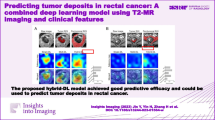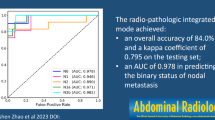Abstract
Objectives
This study aimed to investigate whether a deep learning (DL) model based on preoperative MR images of primary tumors can predict lymph node metastasis (LNM) in patients with stage T1–2 rectal cancer.
Methods
In this retrospective study, patients with stage T1–2 rectal cancer who underwent preoperative MRI between October 2013 and March 2021 were included and assigned to the training, validation, and test sets. Four two-dimensional and three-dimensional (3D) residual networks (ResNet18, ResNet50, ResNet101, and ResNet152) were trained and tested on T2-weighted images to identify patients with LNM. Three radiologists independently assessed LN status on MRI, and diagnostic outcomes were compared with the DL model. Predictive performance was assessed with AUC and compared using the Delong method.
Results
In total, 611 patients were evaluated (444 training, 81 validation, and 86 test). The AUCs of the eight DL models ranged from 0.80 (95% confidence interval [CI]: 0.75, 0.85) to 0.89 (95% CI: 0.85, 0.92) in the training set and from 0.77 (95% CI: 0.62, 0.92) to 0.89 (95% CI: 0.76, 1.00) in the validation set. The ResNet101 model based on 3D network architecture achieved the best performance in predicting LNM in the test set, with an AUC of 0.79 (95% CI: 0.70, 0.89) that was significantly greater than that of the pooled readers (AUC, 0.54 [95% CI: 0.48, 0.60]; p < 0.001).
Conclusion
The DL model based on preoperative MR images of primary tumors outperformed radiologists in predicting LNM in patients with stage T1–2 rectal cancer.
Key Points
• Deep learning (DL) models with different network frameworks showed different diagnostic performance for predicting lymph node metastasis (LNM) in patients with stage T1–2 rectal cancer.
• The ResNet101 model based on 3D network architecture achieved the best performance in predicting LNM in the test set.
• The DL model based on preoperative MR images outperformed radiologists in predicting LNM in patients with stage T1–2 rectal cancer.





Similar content being viewed by others
Abbreviations
- 2D/3D:
-
Two/three-dimensional
- AUC:
-
Area under the receiver operating characteristic curve
- CI:
-
Confidence interval
- DL:
-
Deep learning
- LNM:
-
Lymph node metastasis
- T2WI:
-
T2-weighted image
References
Fields AC, Lu P, Hu F et al (2021) Lymph node positivity in T1/T2 rectal cancer: a word of caution in an era of increased incidence and changing biology for rectal cancer. J Gastrointest Surg 25:1029–1035
Bretthauer M, Kaminski MF, Løberg M et al (2016) Population-based colonoscopy screening for colorectal cancer: a randomized clinical trial. JAMA Intern Med 176:894–902
Hashiguchi Y, Muro K, Saito Y et al (2020) Japanese Society for Cancer of the Colon and Rectum (JSCCR) guidelines 2019 for the treatment of colorectal cancer. Int J Clin Oncol 25:1–42
Brunner W, Widmann B, Marti L, Tarantino I, Schmied BM, Warschkow R (2016) Predictors for regional lymph node metastasis in T1 rectal cancer: a population-based SEER analysis. Surg Endosc 30:4405–4415
Amin MB, Edge S, Greene F et al (2017) AJCC Cancer Staging Manual, 8th edn. Springer International Publishing, New York
Qaderi SM, Dickman PW, de Wilt JHW, Verhoeven RHA (2020) Conditional survival and cure of patients with colon or rectal cancer: a population-based study. J Natl Compr Canc Netw 18:1230–1237
Benson AB, Venook AP, Al-Hawary MM et al (2018) Rectal Cancer, Version 2.2018, NCCN Clinical Practice Guidelines in Oncology. J Natl Compr Canc Netw 16:874–901
Glynne-Jones R, Wyrwicz L, Tiret E et al (2017) Rectal cancer: ESMO Clinical Practice Guidelines for diagnosis, treatment and follow-up. Ann Oncol 28 iv22-iv40
Serra-Aracil X, Gálvez A, Mora-López L et al (2018) Endorectal ultrasound in the identification of rectal tumors for transanal endoscopic surgery: factors influencing its accuracy. Surg Endosc 32:2831–2838
Al-Sukhni E, Milot L, Fruitman M et al (2012) Diagnostic accuracy of MRI for assessment of T category, lymph node metastases, and circumferential resection margin involvement in patients with rectal cancer: a systematic review and meta-analysis. Ann Surg Oncol 19:2212–2223
Bates DDB, Homsi ME, Chang KJ, Lalwani N, Horvat N, Sheedy SP (2022) MRI for rectal cancer: staging, mrCRM, EMVI, lymph node staging and post-treatment response. Clin Colorectal Cancer 21:10–18
Langman G, Patel A, Bowley DM (2015) Size and distribution of lymph nodes in rectal cancer resection specimens. Dis Colon Rectum 58:406–414
Park JS, Jang YJ, Choi GS et al (2014) Accuracy of preoperative MRI in predicting pathology stage in rectal cancers: node-for-node matched histopathology validation of MRI features. Dis Colon Rectum 57:32–38
Borgheresi A, De Muzio F, Agostini A et al (2022) Lymph Nodes Evaluation in Rectal Cancer: Where Do We Stand and Future Perspective. J Clin Med 11:2599
Tang Y, Rao S, Yang C, Hu Y, Sheng R, Zeng M (2018) Value of MRI morphologic features with pT1-2 rectal cancer in determining lymph node metastasis. J Surg Oncol 118:544–550
Grøvik E, Redalen KR, Storås TH et al (2017) Dynamic multi-echo DCE- and DSC-MRI in rectal cancer: Low primary tumor K(trans) and ΔR2* peak are significantly associated with lymph node metastasis. J Magn Reson Imaging 46:194–206
Surov A, Meyer HJ, Pech M, Powerski M, Omari J, Wienke A (2021) Apparent diffusion coefficient cannot discriminate metastatic and non-metastatic lymph nodes in rectal cancer: a meta-analysis. Int J Colorectal Dis 36:2189–2197
Beets-Tan RGH, Lambregts DMJ, Maas M et al (2018) Magnetic resonance imaging for clinical management of rectal cancer: updated recommendations from the 2016 European Society of Gastrointestinal and Abdominal Radiology (ESGAR) consensus meeting. Eur Radiol 28:1465–1475
Dahmarde H, Parooie F, Salarzaei M (2020) Is (18)F-FDG PET/CT an accurate way to detect lymph node metastasis in colorectal cancer: a systematic review and meta-analysis. Contrast Media Mol Imaging 2020:5439378
Crimì F, Valeggia S, Baffoni L et al (2021) [18F]FDG PET/MRI in rectal cancer. Ann Nucl Med 35:281–290
Chan HP, Samala RK, Hadjiiski LM, Zhou C (2020) Deep learning in medical image analysis. Adv Exp Med Biol 1213:3–21
LeCun Y, Bengio Y, Hinton G (2015) Deep learning. Nature 521:436–444
Yin S, Luo X, Yang Y et al (2022) Development and validation of a deep-learning model for detecting brain metastases on 3D post-contrast MRI: a multi-center multi-reader evaluation study. Neuro Oncol 24:1559–1570
Dembrower K, Liu Y, Azizpour H et al (2020) Comparison of a deep learning risk score and standard mammographic density score for breast cancer risk prediction. Radiology 294:265–272
Yin P, Mao N, Chen H et al (2020) Machine and deep learning based radiomics models for preoperative prediction of benign and malignant sacral tumors. Front Oncol 10:564725
Zhang XY, Wang L, Zhu HT et al (2020) Predicting rectal cancer response to neoadjuvant chemoradiotherapy using deep learning of diffusion kurtosis MRI. Radiology 296:56–64
Jang BS, Lim YJ, Song C et al (2021) Image-based deep learning model for predicting pathological response in rectal cancer using post-chemoradiotherapy magnetic resonance imaging. Radiother Oncol 161:183–190
He K, Zhang X, Ren S, Sun J (2016) Deep residual learning for image recognition. Proc IEEE Conf Comput Vis Pattern Recognit. https://doi.org/10.1109/CVPR.2016.90
Chen S, Ma K, Zheng Y (2019) Med3D: transfer learning for 3D medical image analysis. arXiv:1904.00625. Available via https://arxiv.org/abs/1904.00625. Accessed March 24, 2022
Chattopadhay A, Sarkar A, Howlader P, Balasubramanian VN (2018) Grad-CAM++: generalized gradient-based visual explanations for deep convolutional networks. IEEE Winter Conference on Applications of Computer Vision (WACV). https://doi.org/10.1109/WACV.2018.00097
Hillis SL, Berbaum KS, Metz CE (2008) Recent developments in the Dorfman-Berbaum-Metz procedure for multireader ROC study analysis. Acad Radiol 15:647–661
Zhuang Z, Zhang Y, Wei M, Yang X, Wang Z (2021) Magnetic resonance imaging evaluation of the accuracy of various lymph node staging criteria in rectal cancer: a systematic review and meta-analysis. Front Oncol 11:709070
Huang YQ, Liang CH, He L et al (2016) Development and validation of a radiomics nomogram for preoperative prediction of lymph node metastasis in colorectal cancer. J Clin Oncol 34:2157–2164
Li C, Yin J (2021) Radiomics based on T2-weighted imaging and apparent diffusion coefficient images for preoperative evaluation of lymph node metastasis in rectal cancer patients. Front Oncol 11:671354
Lu Y, Yu Q, Gao Y et al (2018) Identification of metastatic lymph nodes in MR imaging with faster region-based convolutional neural networks. Cancer Res 78:5135–5143
Li J, Zhou Y, Wang P et al (2021) Deep transfer learning based on magnetic resonance imaging can improve the diagnosis of lymph node metastasis in patients with rectal cancer. Quant Imaging Med Surg 11:2477–2485
Chang HC, Huang SC, Chen JS et al (2012) Risk factors for lymph node metastasis in pT1 and pT2 rectal cancer: a single-institute experience in 943 patients and literature review. Ann Surg Oncol 19:2477–2484
Xu H, Zhao W, Guo W et al (2021) Prediction model combining clinical and MR data for diagnosis of lymph node metastasis in patients with rectal cancer. J Magn Reson Imaging 53:874–883
Xu L, Zhang Z, Qin Q, Zhang C, Sun X (2020) Assessment of T and N staging with MRI(3)T in lower and middle rectal cancer and impact on clinical strategy. J Int Med Res 48:300060520928685
Mo S, Zhou Z, Dai W et al (2020) Development and external validation of a predictive scoring system associated with metastasis of T1–2 colorectal tumors to lymph nodes. Clin Transl Med 10:275–287
Simonyan K, Zisserman A (2014) Very deep convolutional networks for large-scale image recognition. arXiv:1409.1556. Available via https://arxiv.org/abs/1409.1556. Accessed March 28, 2022
Funding
This research is supported by Capital’s Funds for Health Improvement and Research (CFH) [grant number 2022–2-4024]; the National Natural Science Foundation of China [grant number 81971589]; CAMS Innovation Fund for Medical Sciences (CIFMS) [grant number 2021-I2M-C&T-A-017]; 2020 SKY Imaging Research Fund [grant number Z-2014–07-2003–01].
Author information
Authors and Affiliations
Corresponding author
Ethics declarations
Guarantor
The scientific guarantor of this publication is Hongmei Zhang.
Conflict of interest
The authors of this manuscript declare that Jiesi Hu and Sicong Wang are statisticians from GE Healthcare and control the study data. The other authors declare no competing interests.
Statistics and biometry
Jiesi Hu, Shangying Hu, and Sicong Wang kindly provided statistical advice for this manuscript.
Informed consent
Written informed consent was not required for this study because of the retrospective nature of the study.
Ethical approval
Institutional Review Board approval was obtained.
Methodology
• retrospective
• diagnostic or prognostic study
• performed at one institution
Additional information
Publisher's note
Springer Nature remains neutral with regard to jurisdictional claims in published maps and institutional affiliations.
Supplementary Information
Below is the link to the electronic supplementary material.
Rights and permissions
Springer Nature or its licensor (e.g. a society or other partner) holds exclusive rights to this article under a publishing agreement with the author(s) or other rightsholder(s); author self-archiving of the accepted manuscript version of this article is solely governed by the terms of such publishing agreement and applicable law.
About this article
Cite this article
Wan, L., Hu, J., Chen, S. et al. Prediction of lymph node metastasis in stage T1–2 rectal cancers with MRI-based deep learning. Eur Radiol 33, 3638–3646 (2023). https://doi.org/10.1007/s00330-023-09450-1
Received:
Revised:
Accepted:
Published:
Issue Date:
DOI: https://doi.org/10.1007/s00330-023-09450-1




